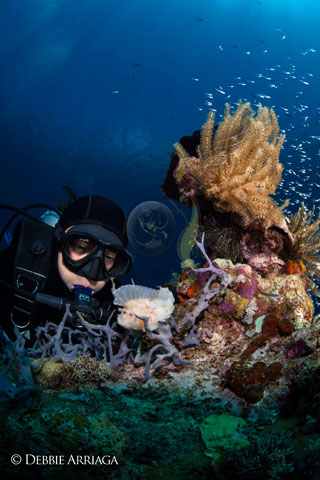All new itinerary to the Forgotten Islands onboard the Arenui, Maumere-Saumlaki – September 4-15 2016 Group Trip – 11nts
Day 1 Embarkation in Maumere
Day 2 Serbete Reef / Adonara Island
 Serbete Reef
Serbete Reef
In the morning we visit the waters east of Tanjung Gedong, where we dive Serbete Reef – a site with shallow reefs and sandbars. The island itself can be distinguished by its small lighthouse. In addition to the exquisite coral gardens in the shallower areas, there are also fantastic walls which make for some nice, varied diving.
Adonara Island
The afternoon dives are on the south-west corner of Adonara Island, east of Flores. There is a very healthy reef in the shallows, where juvenile harlequin sweetlips and barramundi wiggle in between the hard corals. Ribbon eels and numerous nudibranchs can be found between the reef and the slope, which slowly drops down to around 25 metres/75 feet. At the far west end of the dive site there are ledges extending along the sea floor, with blue spotted stingrays, white tip reef sharks and sweetlips sheltering underneath. The eastern part is home to the ‘holy grail’ of fish, the rhinopias. We’ve been able to find both the weedy and the paddle-flap scorpionfish here.
Day 3 Kawula Island
In the south-west of Kawula Island there is a bay with a world class muck diving site.
Tanjung Waiwowan
This dive site is a mixture of reef and white sandy slope, and it’s teeming with amazing critters. Here we have another chance to see the allusive rhinopias camouflaged in the coral slope. This is a perfect environment for all different kinds of ghost pipefish, including the very rare halemeda ghost pipefish. Even the elusive wonderpuss and blue ring octopus have been spotted at this site. During the night dive, brown banded bamboo sharks, helmut flying gurnards and frogfish are seen crawling around the darkened site. We can easily spend a full day here, investigating the hiding spots of all these wonderful creatures.
 Days 4, 5 Alor / Pantar Strait
Days 4, 5 Alor / Pantar Strait
Diving here promises a variety of thrills, as the sites present a wide array of exciting possibilities. The Strait can also be a good place to see passing whales or Mola Molas sunbathing at the surface. Therefore we will combine the diving with some tender rides to try to snorkel with these pelagics.
Pura Island
The topography ranges from dramatic drop-offs, to spurs jutting out from the shore, to giant pinnacles and shallow reefs where the light brings out the full colour of the dazzling corals. The most famous dive site here is Anemone City where there is the largest field of sea anemones in the oceans anywhere. The rocks are no longer visible because all of them, as far as one can see in the usually crystal clear water, are covered with anemones.
Everywhere there is an abundance of fish life, bursting with colourful anthias and damselfish, but this is also famous as a great spot to encounter the many sharks and other pelagics that pass through. However, fans of macro will also get their fill, with several sites offering rare, weird and wonderful critters. Some examples are mandarin fish, all sorts of nudibranchs, snake eels, yellow, blue and black ribbon eels, groups of seamoths and many other remarkable creatures. The only way you are likely to see stranger creatures, is if you night dive here to witness even more unusual critters emerging from their holes.
Also see the famous Pura Island villagers splash out of their wooden dugout canoes and dive underwater with home-made goggles fashioned from wood and glass bottles.
Day 6 Pulau Wetar
Not many people can say that they have dived Wetar Island. It has several calm bays where interesting critters can be found as well as swift drift dives between Wetar and Reong that takes you past a spectacularly coloured wall.
Pulau Reong
The small island of Reong, which lies off the northwest coast of Wetar, presents a change in scenery as it is made of limestone. Sharks, barracuda and schools of other large pelagics frequently visit these waters. Other delights can be found while diving the impressive walls and a site full of diverse marine life.
Tanjung Nunukae
Divers have come across both mobula and manta rays in this area, which is generally characterised by shallows forming a plateau that narrows as it goes deeper until it drops off abruptly, forming a very nice wall swathed in gigantic sea fans, cup corals and impressive sponges. Currents here are generally moderate to strong which is probably why the rays linger in the vicinity.
Day 7 Pulau Romang/Nyata
At Romang and Nyata Island there are gentle slopes resembling huge terraces which slip down into the deep blue of the Banda Sea. You will be able to see huge gorgonians in vivid orange, yellows and reds, carpets of soft corals and massive barrel sponges in all directions. If you manage to tear your gaze off of the life on this wonderful reef and train it into the blue, you will often be rewarded by the sight of majestic napoleons, reef sharks or tuna. Many of the nearby dive spots show signs of volcanic activity on the seabed and are terrific spots for night dives when you can find stunning looking shrimps, elegant Spanish dancers and bobtail squid.
Day 8 Pulau Damar/Terbang
This island provides a chance to get in some good deep dives. From top to bottom, the reef is an explosion of different colours and forms and seems to be in constant motion from the swarms of fish darting about. You may find yourself floating in the midst of a huge school of fish as the sea creatures here appear quite curious, perhaps because they are generally not used to seeing many divers. Another unique attraction in this area is the wall of sulphur formed as a result of its proximity to the volcano on Damar.
Days 9, 10, 11 Teun, Nila and Serua
Teun, Nila and Serua, often referred to as TNS, are all small, very remote volcanic islands only accessible by liveaboard, located just east of Damar. You will feel as if you have reached the ends of the earth which may be why there is a growing interest in diving in this zone. Although the sites here remain relatively unexplored, experiences so far have revealed tremendous diving potential and splendid coral reefs. It is possible to do a shore excursion to one of the islands.
Day 12 Disembarkation in Saumlaki
COST: $6270.00 per person
Fuel charge $100 per person
Port fee $150 per person
Park fee $120 per person








